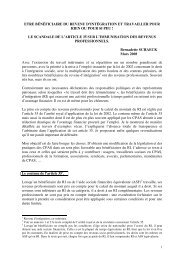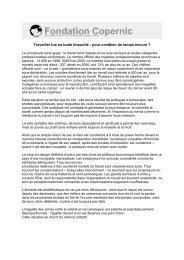Awra Amba RJ 300612 EN - Contacter un comité local d'Attac
Awra Amba RJ 300612 EN - Contacter un comité local d'Attac
Awra Amba RJ 300612 EN - Contacter un comité local d'Attac
Create successful ePaper yourself
Turn your PDF publications into a flip-book with our unique Google optimized e-Paper software.
55 / 85<br />
4. Social organisation<br />
(3.7 persons instead 5.2) according to Ya08/95. It was 3.8 persons in 2005 (At05/33-34) and 3.4<br />
persons in 2008 (Me09/37), to compare to the figures from the 2007 census: 4.5 and 4.4 persons per<br />
household in the rural kebeles of Amhara region and in the Fogera woreda respectively (CSA,<br />
2007/317 & 325). There is therefore aro<strong>un</strong>d one person less per household in <strong>Awra</strong> <strong>Amba</strong>.<br />
Married women have an inalienable right to contraception (natural as well as artificial ones) without<br />
the knowledge of their husbands if necessary, an all are aware of contraception (awraamba, nd;<br />
Ya08/77 & 82) (Question 25 in Annex). Contraception is anyway widely used in Ethiopia. The<br />
comm<strong>un</strong>ity considers that a woman older than 45 should no longer have children. Nevertheless, the<br />
comm<strong>un</strong>ity does not demand the right to abortion, illegal but openly discussed in Ethiopia. They<br />
think that abortion remains a private affair, always possible in a private clinic in town (Jo10b).<br />
Premarital sex and sex outside marriage should be forbidden (Jo10b). It seems rather according to<br />
(At05/42 & 79) they are now disapproved without being openly criticized; the limited number of<br />
potential partners, given the difficulty of marriages outside the comm<strong>un</strong>ity, could explain partially<br />
this situation (Question 26 in Annex). Finally, prostitution is prohibited (Ya08/85).<br />
Rape is of course forbidden, and a boy accused of rape can be banned from the comm<strong>un</strong>ity or have to<br />
wait for a long years to get married (At05/42). Atnafu thinks the most important control mechanism<br />
over the sexual life before marriage is a rigorous self-discipline based on the values and principles of<br />
the comm<strong>un</strong>ity.<br />
4.4.2. Divorce<br />
It is easy a spouse to obtain a divorce, that is moreover frequent in Ethiopia, although it goes still<br />
often against the tradition in some rural areas (France 24, 2009). A couple may divorce without<br />
formalities by mutual consent (At05/42). Nevertheless, divorce must be justified to be allowed by the<br />
comm<strong>un</strong>ity: the acceptable reasons are among others sexual incompatibility, sterility, laziness,<br />
existence of repeated disagreements, and violating rights of the partner. According to a survey<br />
among the heads of households, these reasons are also the reasons of divorce at 35, 32, 17, 15 and<br />
2 % respectively (Ya08/81-82). In 5 years, only one people, a woman, filed for divorce in a court of<br />
law (Me09/54).<br />
Yo<strong>un</strong>g children remain with their mother, while older children choose with whom they wish to live<br />
(Crespo, 2012). The property of the couple is shared equally (At05/42).<br />
A widow can remarry any time, which is not the case in the traditional Amhara society (At05/42).<br />
The frequency of divorce has lowered and they are now quite rare. Atnafu (2005/79) explains that by<br />
the geographic stability of the comm<strong>un</strong>ity members, <strong>un</strong>like the former exile period, and by the<br />
growing opposition in principle to divorce among the former <strong>Awra</strong> <strong>Amba</strong> children now adults.<br />
4.4.3. Homestead<br />
Levine (1965/56) states the traditional Amhara peasant homestead consists of from one to six small<br />
ro<strong>un</strong>d structures, built of wattle and capped with conical thatched roofs. The richest homesteads have<br />
one building for eating and sleeping, one for animals, one for grain storage, one as a kitchen, and one<br />
for guests, while for many peasants all these f<strong>un</strong>ctions are met by a single large building. The<br />
homestead is for both parents and their <strong>un</strong>married children, possibly a yo<strong>un</strong>g married son or daughter<br />
and a yo<strong>un</strong>g relative. The wealthier the peasant, the more relatives and servants will be fo<strong>un</strong>d in the<br />
homestead (At05/44-45).<br />
In <strong>Awra</strong> <strong>Amba</strong>, family houses have wattle-and-daub walls and a roof made of thatch and more and<br />
more of iron sheeting (see Picture 12). Unlike Amhara houses, they are rectangular. The house of the<br />
fo<strong>un</strong>der and leader is larger than others (At05/37). The comm<strong>un</strong>ity members usually build<br />
themselves collectively the houses and the other collective structures. Both men and women do the<br />
planning and most of the manual work. They prepare the material first and then bring them to the

















